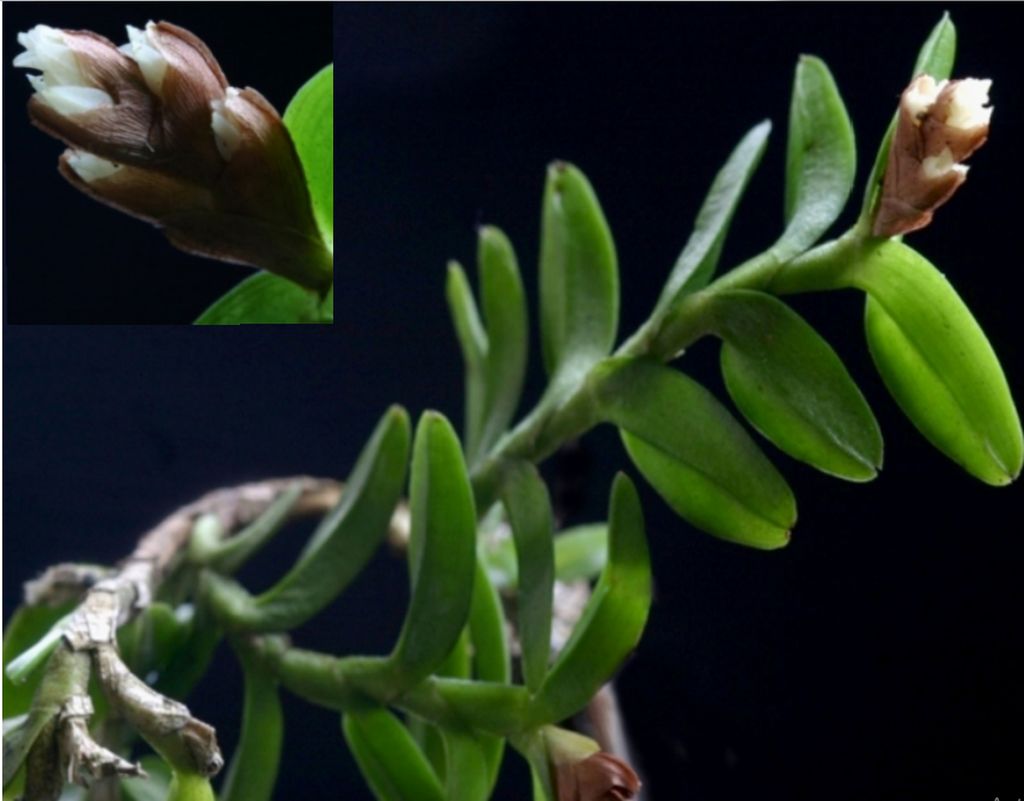

Epidendrum rodriguesii Cogn. 1898 GROUP Ramosum SUBGROUP Flexicaule
Photo by © Luis Felipe Varela/Drawing by R Jimenez and The AMO Herbario Website





Common Name Rodriques Epidendrum [Brazilian Orchid Botanist 1800's]
Flower Size .6" [1.5 cm]
Found in Brazil on stunted shrubs and wind pruned trees on mountain tops and ridges at elevations of 5 to 1000 meters as a miniature to small sized, hot to warm growing, fleshy epiphyte with branching, short, the new stems produced from the nodes of the previous stem and from the base of the inflorescence, thus appearing to be longer, terete at base, laterally compressed towards the apex, fractiflex, the branches generally shorter than the previous stem, but sometimes equal or even longer stems enveloped by leaf sheath bases and carrying 4 to 8 on the primary stem, 2 to 5 on the branches, spreading, distributed throughout the stem, articulate, carinate, deciduous, succulent, distichous, with tubular rugose basal sheaths, blade carinate, ovate-elliptic when spread, apex acute, mucronate, margin entire, surface rugose leaves that blooms in the summer and fall on a short, terminal, without a spathe, peduncle .4 to .6" [1.0 to 1.5 mm] long, covered by 1, rarely 2 bracts, similar to the floral bracts, .6 to .8" [1.5 to 2.0 cm] long, apical, simple, distichous, succesivley 3 to 4 flowered inflorescence with each flower protected by a stout, opaque, snail-shell like, yellowish floral bract and carrying whte flowers with no detectable fragrance.
CAUTION Many references including Kew place this species as a synonym of E strobiliferum. I have separated them as the flowers seem different as well as the bloom time and the prefered location of this species is so different from E strobiliferum's typical habitat.
CAUTION!!!! In 2010 Hagsater reduced this species to a synonym of E strobiliferum in Icones 13 on Plate 1390 and reinstated it in Icones plate 1655 Hagsater 2018.
"Epidendrum rodriguesii belongs to the GROUP Ramosum which is characterized by the monopodial, branching stems, the spike-like, distichous inflorescence, and the single callus, and the 1898 GROUP Ramosum SUBGROUP Flexicaule which has a straggling plant habit, where the main stem is not very evident, and the sepals have a dorsal keel which is generally prominent. The species is recognized by the short plants, up to 6.8" [17 cm]long, without and evident main stem, the new stems, 1.2 to 2" [3 to 5 cm] long produced from the basal nodes or the inflorescence of the previous stem, ovary scarcely verrucose, flowers green to greenish white, sepals .12 to .152" [3.0 to 3.8 mm] long, 7-veined, lip triangular-cordiform, callus a single-bilobed platform, giving the appearance of two calli, disc of the lip with a central, low rib which disappears near the apex of the lip; column with a pair of wide, acute teeth. Similar to Epidendrum strobiloides Garay & Dunsterv., a species endemic to the Guianas, the Gran Sabana in Venezuela and the Amazon slope of Ecuador, flowering from April to June, has shorter, compact plants, .8 to 2.8" [2 to 7 cm] tall, with short stems produced from the apex of the previous stem, flowers small, pale green, sepals .072 to .1" [1.8 to 2.5 mm] long, ovary .08 to .1" [2.0 to 2.5 mm] long), sepals 3-veined, ovary unornamented, the lip with a single callus covering 4 cavities separated by 3 low veins, with the central vein nearly reaching the apex of the lip. Epidendrum strobiliferum Rchb.f. is widely distributed throughout the neotropics and forms large massive plants, 8 to 12" [20 to 30 cm] long, with comparatively large flowers, cream to greenish white, sepals .136 to .172" [3.4 to 4.3 mm] long, ovary .184 to .24" [4.6 to 6.0 mm] long, and the callus “Y” shaped, ovary unornamented. Epidendrum cornanthera F.Lehm. & Kraenzl., a species from Colombia, Ecuador and the Atlantic side of southern Panama, has pendent plants, larger flowers with sepals .2 to .24" [5 to 6 mm] long, ovary .2 to .28" [5 to 7 mm] long, lanceolate sepals, the callus on the lip is a plate over two cavities, column with a pair of apical incurved teeth. Epidendrum luckei Bock is found along the Pacific lowlands in the Darién in Panama, through Colombia to Ecuador, below 550 meters altitude, plants are up to 24" [60 cm] long, with an evident main stem, larger flowers with sepals .2 to .248" [5.0 to 6.2 mm] long, petals .2 to .24" [5 to 6 mm] long, flowers green somewhat suffused with brown, with the anther and apex of the column purple, lip with a tridentate callus, the mid-tooth longer, anther ending in a pair of laminar, elongate horns, column arching upwards at the apical half." Hagsater etal 2018
Synonyms
References W3 Tropicos, Kew Monocot list , IPNI ; Orchidaceae Brasilense Band 1 Pabst & Dungs 1975 drawing fide; The Organ Mountain Range Its History and its Orchids Miller, Warren, Miller & Seehawer 2008 as E rodriguesii drawing/Photo fide; Icones Orchidacearum 13 plate 1390 Hagsater & Sanchez 2010 See synonyms in header; Icones Orchidacearum 16[1} Plate 1655 Hagsater & Sanchez 2018 drawing/photo fide;
--------------------------------------------------------------------------------------------------------------------------